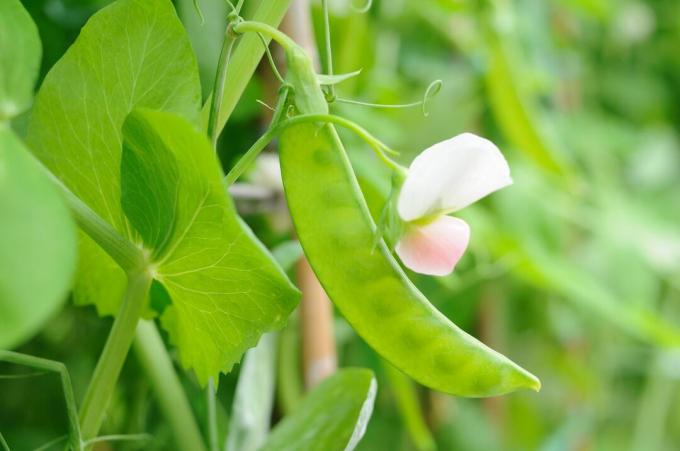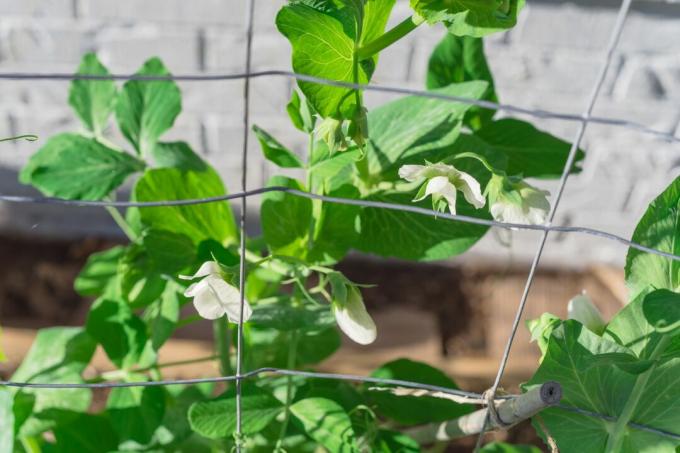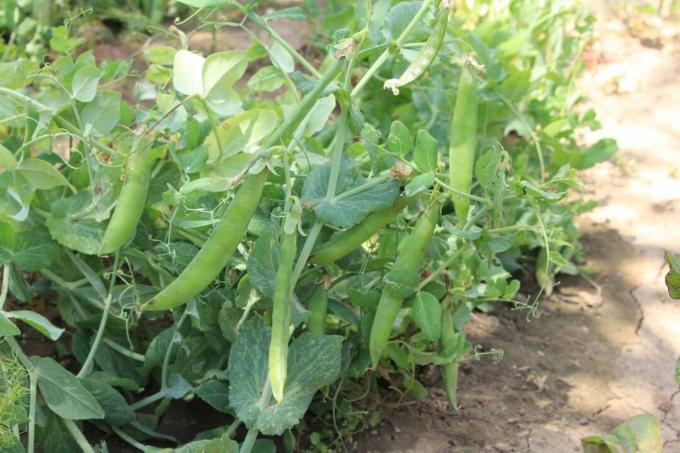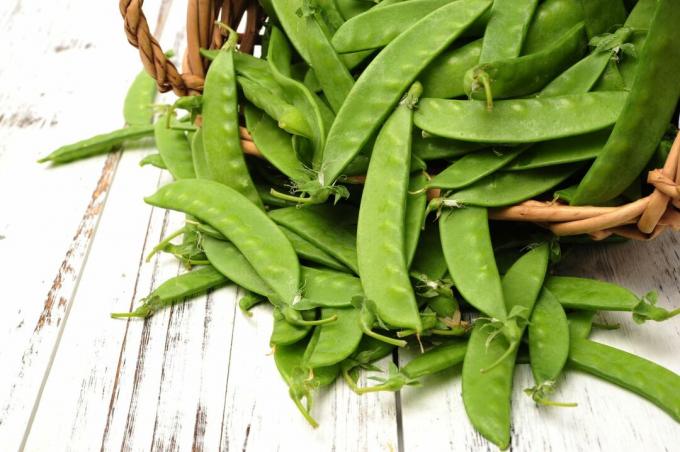The sugar snap peas are a popular summer vegetable from your own garden. We will give you all the important tips to successfully cultivate sugar peas at home.

A few years ago they were classic Marrow peas still the most popular variety of peas. Today the crunchy and sweeter sugar peas apply (Pisum sativum subsp. sativum convar. axiphium) as a consumer favorite. The exact origin of the sugar pea has not yet been clarified due to its long use, but it is suspected to be in India or North Africa. Sugar snap peas were already used as a source of protein and the basis of many dishes in ancient times.
contents
- Sugar snap peas: origin and characteristics
- Planting sugar snap peas
-
Care of sweet peas
- Pour and fertilize sugar peas
- Cut the sugar snap peas
- Grow sweet peas in the pot
- Harvest and store sugar peas
- Taste and uses of sweet peas
- Common pests and diseases on sweet peas
Sugar snap peas: origin and characteristics
Depending on the region, the sugar peas is known by many names such as kefen, snow peas, crackling peas, snow peas or mangetout. It belongs to the genus of garden peas (
Pisum sativum) and is therefore part of the Butterflies (Faboideae), a subfamily of legumes (Fabaceae or Leguminosae). The sugar pea plant grows as an annual, herbaceous plant that reproduces via the fruits, which are formed in pods. It forms climbing or creeping bluish-green main shoots that can be up to 1.5 meters long and are occupied by leaves. In addition to the main shoot, several thin side shoots can be formed. The egg-shaped leaves are usually entire and only rarely serrated. As with garden peas, the inflorescence of the sugar pea is made up of one to three flowers. The white sepals are usually fused together like a bell and are adorned with a corolla. The pods, which are around 10 cm long and each contain between four and ten round seeds, finally develop from the fertilized flower.
In delicatessen shops in particular, sugar pea pods often come from overseas and are transported to Germany by air. In the meantime, however, the vegetables are also grown commercially in some areas of Germany with deep and nutrient-rich soils. Cultivation in your own garden is also easily feasible with a little background knowledge.
Planting sugar snap peas
The sugar snap peas hardly have any special location requirements: A deep soil in a sunny, airy location already provides the best conditions. On the other hand, very sandy and very heavy clay-rich or compacted soils are unsuitable. A soil rich in humus, which can hold water well, but does not tend to waterlogging, is ideal. Compaction in the subsoil is not conducive to pea cultivation, because this is where root rot can occur more easily. Anyone who has been growing vegetables in the same bed for a long time can occasionally fall back on the help of a soil activator, which promotes soil life and can increase the humus content. In this way, a good supply of nutrients to the plants is ensured and the soil is sustainably protected so that vegetables can also be grown in the future. Our Plantura organic soil activator for example, it is able to create a symbiosis between fungus and plant through the additional mycorrhizal fungi it contains. This supports the plant in its water and phosphate supply. Thanks to the purely biological components and the absence of animal components, our Plantura organic soil activator is also sustainably produced and so is the environment.
The sugar pea is one of the low-eating vegetables. It absorbs fixed nitrogen through a symbiosis with nodule bacteria, which it brings into the soil during later incorporation. Since the sugar pea is poorly self-tolerant, a break of around four to six years should be taken between cultivation in the same area. This prevents the transmission of foot and wilting diseases such as fusaria. A mixed crop cultivation is easy with Carrots (Daucus carota subsp. sativus), Cabbage varieties (Brassicaceae), fennel (Foenicum vulgare), Lettuce (Lactuca sativa) or radish (Raphanus sativus var. sativus) possible.
The best time to sow the sugar peas is between March and the beginning of April, as damage due to prolonged periods of frost can no longer occur here. If you sow the seeds too late, a lower yield is possible due to reduced flower formation. In milder regions, sowing is usually possible from the beginning of March, the sugar peas can withstand short frosts without any problems.
The sowing takes place directly in the bed, for this purpose approx. 3 to 5 cm deep seed grooves are drawn into the loosened soil with a garden rake. Ideally, the grooves are oriented so that they run in a north-south direction. This ensures even exposure of the plants and thus even growth of the pods. A row spacing of about 35 cm should be maintained between two grooves so that the sugar pea plants have enough space for healthy growth. You can also set up a climbing aid in the intermediate area so that the plant can grow upwards. In this way, the sugar peas reach a height of up to 1.5 meters. Then the seeds can be placed in the groove at a distance of about 10 cm before it is closed and the soil is gently pressed. Finally, the soil should be well watered to encourage germination. The sugar peas begin to sprout after just one to two weeks.

tip: For sugar snap peas - as well as for other climbing crops - it is helpful to use a climbing aid. This increases the yield and at the same time improves the quality of the peas. Through the sugar pea climbing aid, even light reaches all parts of the plant, so that the fruits can grow and ripen better. In addition, harvesting is easier because you can see most of the pods at first glance and don't have to look for them.
Growing sweet peas at a glance:
- The sowing takes place between the beginning of March and the beginning of April directly in the bed.
- The sugar pea seeds should be placed in a seed groove about 3 - 5 cm deep. The distance between the grains is about 10 cm, the distance between the rows about 35 cm.
- At temperatures of 10 to 18 ° C, the sugar pea seeds germinate within one to two weeks.
- A climbing aid improves yield and quality. In addition, the harvest is made easier.
In addition to the sugar pea, there are a large number of other types of pea. You can also read our overview of new, tried and tested and resistant ones Pea varieties.

Care of sweet peas
During the vegetation, the maintenance effort for the sugar peas is moderate, especially if the site conditions are right. Weeds should be raked once a week after sowing and before germination. So there is no competition for nutrients and light between the sugar snap peas and the weeds. As soon as the plants are about 15 cm tall, they start to suppress the weeds by their own growth. Raking is only seldom, usually no longer necessary. In addition, the soil around the young plants can now be piled up, which promotes the formation of lateral roots and thus improves the uptake of water and nutrients. In addition, the plants can be guided in the direction of the climbing aid and attached to it with the first shoots. During growth, it is important to regularly guide the sugar peas further up the trellis so that all parts of the plant receive the same amount of light and can grow well.
The sugar peas are not hardy. As annual, herbaceous plants, they die in autumn and naturally sprout again in spring through the seeds from the pods.

Pour and fertilize sugar peas
Thanks to its deep roots, the sugar pea is able to supply itself well with water. However, until the seeds germinate, it is important to keep the soil consistently moist to support initial growth. In dry regions and during longer dry periods in summer, regular watering is important so that the plants do not dry out.
Sugar peas are legumes that live in symbiosis with so-called nodule bacteria. These nodule bacteria are able to fix nitrogen from the air, convert it into nitrate and thus make it available to the plants. With healthy soil conditions, further fertilization is not necessary throughout the vegetation.
Cut the sugar snap peas
A cut is not necessary with sugar snap peas. If the growth becomes too overgrown, long-protruding shoots can easily be returned to the climbing aid. However, they can also be cut off if necessary. Sick or dry shoots and leaves should be removed regularly.
Caring for sweet peas properly:
- Initially, weeds should be kept small and raked.
- Regularly guide along the trellis during growth so that all parts of the plant receive the same amount of light.
- Sugar peas are legumes and live in symbiosis with nodule bacteria that can bind nitrogen from the air. Additional fertilization is therefore not necessary.
- If it is dry, it must be watered regularly.
- The sugar pea does not need to be cut.

Grow sweet peas in the pot
Sweet peas can also be planted in pots if you keep a few points in mind.
Due to the sensitivity to longer cold spells, the sugar peas should not be brought outside until mid-April, but they can be preferred in the apartment.
The pot should be big enough as the sugar pea develops a deep root system. A high-quality vegetable soil is suitable as a substrate, which thanks to its composition ideally supplies the plant with nutrients. Because of the loose structure of the earth, healthy root growth is supported at the same time. Our Plantura organic tomato and vegetable soil, not only meets the requirements of the plant, it is also made from sustainable, biological materials and does not require any peat at all. The further procedure for sowing is the same as for bedding - only the sugar peas can be sown more densely at a distance of about five centimeters.
It is important to ensure an even water supply in the pot, as the plants cannot fall back on water from deeper layers of the earth.
Harvest and store sugar peas
The harvest is usually possible from June when the pods are still light green and you can see the peas inside from the outside.
To harvest the sugar peas, you can pluck the ripe pods off the plant and collect them. The pods should not be stored for too long, as after one or two days at the latest the sugar they contain will increasingly transform into starch and the taste will change as a result. The freshly harvested sugar peas can be blanched briefly and then safely frozen in order to gently thaw them again at a later point in time. Overripe pods quickly lose their taste and quality.
Taste and uses of sweet peas
As the name suggests, the taste of sugar peas is significantly sweeter than other types of peas. You can already harvest young, not quite ripe pods. These are very suitable for eating the sugar peas raw. In contrast to peas, sugar peas do not have a layer of parchment inside the pod, which is why the pods can be eaten whole. Hence the name "Mangetout", which was adopted from French: The French "Mange tout" means "eat everything". The pods can also be cooked, fried or boiled very well.
tip: A cross between pulp peas and sugar peas, so-called “pulp sugar peas” or snap peas, is also popular. As with sugar peas, the pods can be eaten whole, while the grains inside are larger and crunchy, as with pulp peas. Their taste is slightly sweet.

Frequent Pests and diseases on sugar peas
Fungal diseases and peeling can occasionally cause problems for the plant. The infestation with the Powdery mildew favored. In contrast to other fungal diseases, this can attack the plant even if the leaves are not wet, and it can be dry and warm during the day. To prevent an infestation, it can help to grow the sugar peas in a location that is already in the sun in the morning and to water them in the morning instead of in the evening. Powdery mildew-resistant varieties have been developed through breeding, which are used particularly in home gardens and in organic farming.
Of the Fusarium mushroom is the second major antagonist that often attacks legumes such as sugar peas. If the plant is infected with Fusarium, the leaves first discolor slightly, then wither and turn black in the final stage. By considering a suitable crop rotation, you can prevent an infestation with the Fusarium fungus.
The pea moth is the only relevant animal pest on sugar peas. It attacks them mainly between May and June, when the plants form the fruit pods. If the pest has already been spotted in your own or in the neighboring garden, you should use a protective net during the entire time to keep it away from the healthy plants.
Are you still looking for other exciting vegetables for your garden? Like, for example, the perennial Sea kale we can tell you here how to plant and care for them.

